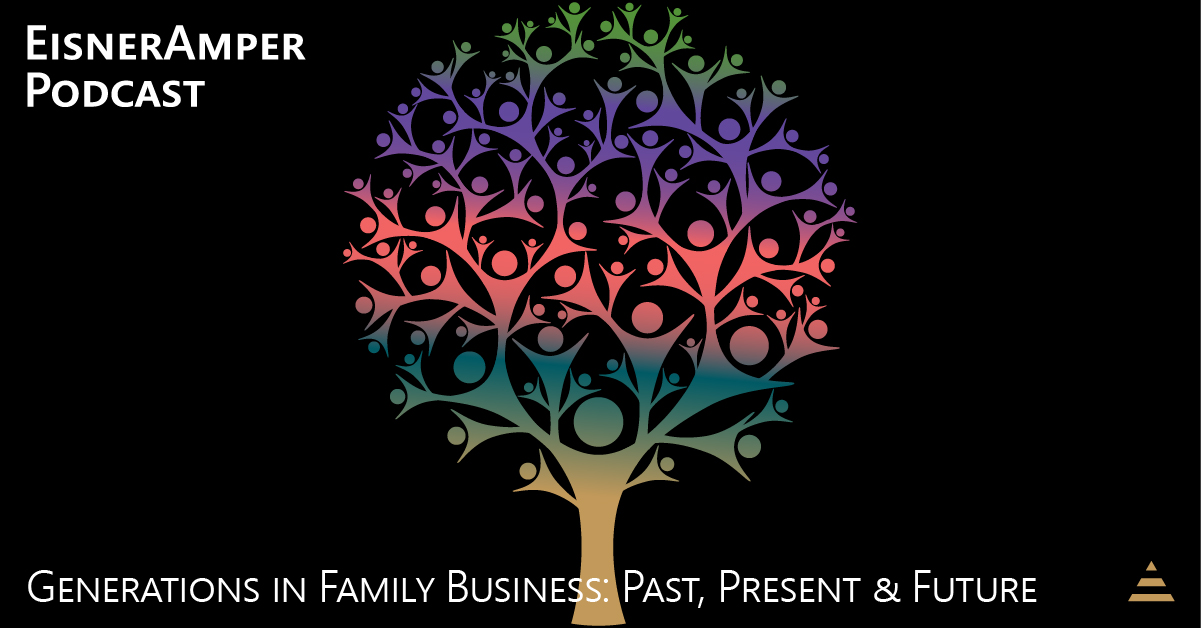
Succession Planning Process: Growth and Values
- Published
- Dec 16, 2019
- Share
Matt Kerzner and Tim Schuster discuss the third step in the process for succession planning, Growth and Values.
Transcript
Tim Schuster: Hello and welcome to our podcast for “Generations in Family Business, Past, Present, and Future. Our hosts for this podcast are myself, Tim Schuster, and I'm a senior manager in the Center for Family Business Excellence. And with us, as always, is our good friend.
Matt Kerzner: Tim, how are you? This is Matt Kerzner. I'm the Director in the Center for Family Business Excellence.
TS: We're going to continue our conversation in the process that we have for a succession planning, right? So our last topic of conversation had to do with governance. And today we're going to discuss growth and value enhancements. So why don't we start off by defining them, right? You know, what is growth? What is value enhancement?
MK: Growth is, what is the business development, right? What is the growth of the business look like? What is the one-year, three-years, five-years look like for your business? What do you need to do to help transfer the value of the business? And what is the predictability of increased value.
TS: Exactly.
MK: And then the last one for growth and value enhancement. I would be a miss if I didn't talk about people development, right? What is leadership development, management development, what is the path to progression for people? What is the transition? The whole succession planning piece.
TS: Exactly.
MK: So it's not just growing the revenue, it's growing everything that's part of the business.
TS: Yeah, and that makes sense. Something else that actually is in our tool shed right now, which is called value builder. I mean this is that holistic approach that we take with companies. So a lot of times, and Matt can attest this as well, we have businesses that come to us that just are looking for something. They're looking for a value of some degree.
And in our wheelhouses here is actually a service that we offer where we can take a company and help them with that. And what's nice is where most of the time companies might think that they're worth more than they really are. Sometimes it's an eye-opening experience. And what we do as advisors, Matt and myself, is we actually go through and we can help them get to where the value that they hopefully will get with their company.
So there's a series of questions that we'll take someone through and then through the course of a year or a couple of years, Matt and I will take people and help them get to where they need to go. So it's nice. So we're going through, taking them through this process, helping them increase their value, getting their presence around and it could be little facets.
MK: You know, Tim, we talked about in previous podcasts, we've gotten into the strategic roadmap and you always ask a great question. How does this come back to the-
TS: How'd you know I was going to go down that path?
MK: I knew it. But think about that. We're talking about growth in value enhancement and part of this whole strategic roadmap activity is growth and value enhancement. How do you grow that business? A lot of times entrepreneurs say, "I know what the value of my business is." It's two, three times the amount of …
TS: EBITDA or something.
MK: All that stuff. But you know what, and then they start thinking about, "Okay, I don't have a family member ready to take the helm. I'm going to bring in an external non-family member to run the business." But wouldn't you want to know what the value of your business is to either know you're on target or you have to take a step back and put a plan together.
So you know, it's not just growing the business as I talked about, it's also looking at operation efficiency, doing things better, faster, with more quality, looking at, picking up the rock, and looking at all these things. And that includes the people side of it. So I use the three major pillars in the strategic roadmap exercise. The value-builder tool is a wonderful opportunity for an organization to really take a look at where are they currently are now and what's that path for them for the growth of the business.
TS: So Matt and I have been talking about this in multitude of podcasts where we have this great transition coming. Ten trillion dollars in assets are going to be transferred over the next 10 years, 15 years. So Matt, how can we as advisors go down that path to make sure that one, a company is getting the money that they're going to get, because the transition is going to occur. But, two, how can we help them get to where they need to be?
MK: Yeah, that's great. So I think, family owned businesses, closely held businesses, they might not have an advisory board or a fiduciary board that's accountable. But I don't know if it's the owners, but it could be the people who are the C-suite office that's running the business, the CEO. How do they keep them on target and hold them accountable to grow the business? And sometimes owners, the C-suite or middle management, or even the line folks, are just so busy working the business that they actually don't take a step back and say what can we do to grow it, strategically?
TS: Right. They're in the weeds.
MK: They're in the weeds. When we talk about this succession planning process, we already talked about the transition and exit strategy. We talked about family governance and here we are, we're talking about growth and value enhancement. It would be foolish for the owners and CEO and the board not to take a step back, look at the current landscape and then say, "Let's get a snapshot of where we are for the value. Because I know where I want to be either to pass it to my family or to maintain my lifestyle for the rest of my life. Or I might have to sell. But I really don't know what the value is. And I know what I need to live, but I'm not getting what I need."
TS: You know what's interesting too. So I think some business owners are surprised when they see what their companies are worth, but it can change. I mean there's a lot of instances where you get a number, but that said number is as of a certain date. As of this date, we think this company is worth this. But I think what we should reiterate with our listeners here is that if someone has that opportunity, and you said it perfectly in the beginning, if you know you're moving along in this speed five years, 10 years, what's your plan? Now's the time to start going through this process. Right now. Even if you just start your company, it's something to have this conversation with.
But if you think your transition is happening soon, this is the time to reach out to myself or Matt or someone in this field to help with this.
MK: I agree. The third major step of a six-step process that we use in the Center to help people get ready for succession. And when it comes to growth and value of the business, it really could put the peace of mind to the owner and the family to know, "I'm okay, I'm ready." But if they don't know or they're not growing, they might not feel comfortable and say, "You know what? I need another two years. I need another three years," and they're ready to go now physically, but mentally, they're just not ready yet.
TS: That makes sense. Hey, Matt, thank you so much for being here today. And thank you for listening to “Generations in Family Business Past, Present, and Future” as part of the Eisner Amper podcast series. If you have any questions or there's a topic you'd like us to cover, email us at contact@eisneramper.com. Visit eisneramper.com, for more information on this and a host of other topics. We look forward to having you listen in on our next EisnerAmper podcast.
Also Available On
More in this Series

Succession Planning Process: Growth and Values

Succession Planning Process: Transition & Exit Strategy

Succession Planning Process: Governance

Succession Planning Process: Execution & Accountability

Succession Planning Process: Leadership & Development
What's on Your Mind?
Start a conversation with Timothy
Receive the latest business insights, analysis, and perspectives from EisnerAmper professionals.












